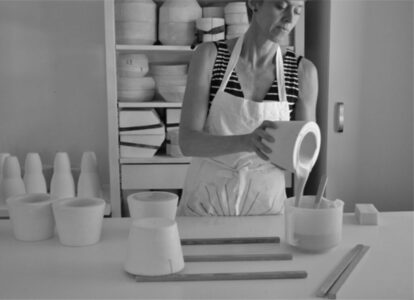As I arrived at the Grand Bellevue Hotel in Gstaad about half an hour before the aperitif was to begin, I was escorted to the bar of the hotel’s restaurant Leonard, where the dinner would take place. There, I saw chef Bottura and his entire kitchen team having a meal together, as they do before each service following their tradition. It is both a stress release and a bonding opportunity, which they were clearly enjoying.
Is there a better way to begin this meal than where it all started: as a walk in the garden of the hotel which Massimo Bottura has dedicated to his mother, Maria Luigia? You are presented with a bowl that seems to hold the essence of nature itself, a bit of garden, and just as with real garden soil, you see a dark mixture on which are some joyous fresh leaves.
There is no time to decipher what the dark could be as the attentive staff pours a delicate warm (not hot) broth on it and instantly, the various textures become a whole. In each spoonful we try to incorporate all the layers, including one that is underneath the “soil”, and which is similar to a chawanmushi, a Japanese egg custard.
The first instinct is to try and identify what is part of the beautiful bouquet that seems to blossom in your mouth. It reminds you of something, but what? You imagine the chef and his team walking through the garden and taking everything that is fresh. What did they pick? Very quickly the exercise seems futile and instead of deconstructing it, we simply want to enjoy the perfect balance that was created.
The flavors fall into several categories: the earthy beans which had formed the “soil” ground the dish, the very light herbs bring joy and freshness, and the silky custard is like a delicate and flavorful caress to the palate. The broth is light and summery, and we wonder what memory the chef is recreating here… but if he grew up in such a garden, there is no wonder that he became so intent on featuring such ingredients in his cuisine.
Chef Bottura took the time before the meal was served to explain the story behind every dish, and the next one is inspired by the Levante. This wind blows across the plains of the river Po in the northern part of Italy, creating a microclimate and allowing for fruits and vegetables which normally only grow in the South to thrive on the shores of the northern lago di Garda.
To honor these ingredients, the chef has made an essence out of them, without bringing them to the heat. The rice, which is also grown by the Po river, is then cooked in this essence taking in all the flavor that compose it. As we are about to take our first taste, the attentive staff sprays above the dish a bit of essence of orange, drops of which delicately fall on the rice and complete every mouthful with a citrus scent.
There is another surprise at the bottom of the dish: a layer of bollito misto, which as the chef explained offers an “upside down crust” of sorts, presenting a third layer, and offering a foundation with its tender texture to the delicate infused rice and the citrusy air.
The third dish is perhaps the most directly related to the traditions that have formed chef Bottura. He was born and raised in Modena, growing up on regional food, with – according to him – “aceto balsamico flowing through his veins, and Parmigiano Reggiano providing the protein of his muscles”.
From his youngest years, he appreciated and savored the flavors and quality of the Modenese ingredients, and spent many years in the kitchen hiding from his older brothers, often under the very table on which his grandmother was making tortellini, which he would promptly and regularly sample, even raw…
Years later, he has become a supporter of the Il Tortellante project which gives a therapeutic environment and an activity opportunity to autistic children and grandmothers who make tortellini pasta together. It is also didactic, teaching them collaboration, the value of time, and brings them self-confidence, impacting in the long run their interactions with others. The tortellini made by the Il Tortellante have become quite famous and they are the ones which we are being served with a Massimo Bottura sauce.
True Parmigiano Reggiano, the wheels of which can be officially fire stamped with that name, is made from the milk of a specific breed of white cows from the Appenine region. While the cheese is made from that skimmed milk, chef Bottura uses the cream that remains from the process as well as 36 months aged Parmigiano Reggiano to make the sauce that accompanies the tortellini. A lavish topping of Summer truffles completes this generous dish.
The following course is a beautiful presentation of contrasts. It begins with the very first look: on the left is a delicate, traditional Modenese Tigelle, the closest I could compare it to would be a pancake, and on the right is a colorful assembly of flower petals and green leaves which we imagine would be precisely what would have fed the veal that they cover. While the veal is still invisible, its potent smoky scent trumpets the arrival of a much stronger flavor.
As we start sampling the refreshing petals and leaves, we discover a veal that is meltingly tender and extremely flavorful. It was smoked in cider and juniper wood for 24 hours, and almost falls apart at the touch. The sauce made of the veal juices was inspired by American barbeque tradition, but with different ingredients such as mustard seeds, elderflower vinegar and apricots as described in the accompanying notes. A horseradish cream sauce perfectly complements it all with a fresh zing.
The fifth dish is very interesting even in its presentation. It is called “budino di cipolla” but does not essentially consist of onions, it is meant to recall a “crème caramel”, but without cream nor caramel, and yet it perfectly makes us think of all three. It consists of subtle foie gras, cooked within the flavors of ginger and lapsang souchong. It is fragrant and elegant, covered with a very fine meringue on top, but which is not overpowering in its sweetness.
Underneath you might find some light onions as a surprise, and on the side, some very small yet beautifully presented candied ginger cubes and very finely cut orange peel are like the period at the bottom of several exclamation points.
Often, a sorbet that precedes the dessert could be considered a palate cleanser and be barely noticed, but it was absolutely not the case here with this delightful dish. The attentive staff had warned me to not drink anything but water with it and I am delighted that I followed their advice. A dark red berry granita posts a sharp visual contrast on what at first looks like an immaculate meringue kiss.
This dish was dedicated to Josef Beuys who was a sharp defender of nature through his art, going beyond statements, and interacting directly with the wild. Here, underneath that delicate white meringue is a gelee of wild berries, so strong in flavor that it transports us to the woods. Beyond that is the meringue which seems to carry in it the very essence of the forest, the sap of a tree. The chosen flavors are all symbolic and extremely powerful, coming together and leaving us feeling as if we had been invited to taste the soul of the forest itself.
Chef Bottura finished with a traditional Italian dessert: zuppa inglese, in which he kept all the ingredients but presented each of them differently from the original either in texture or temperature, in such a way that they were featured individually and as a whole in this unexpectedly light trifle. The dessert is crowned with a dark, Peruvian chocolate foam, beautiful Alkermes liquor is poured as a broth at the very bottom and permeates the angel food sponge cake that holds within its layers a delicious vanilla custard.
The event which I have just described took place at the beautiful Grand Bellevue Hotel in Gstaad and chef Bottura took the time to thank the director, Daniel Koetser, who when they met several years ago instantly knew that they should do something together. Their successful collaboration has lasted several years. He asked his kitchen staff to come out and take the applause as well as the serving staff of the hotel’s restaurant Leonard, who have presented his dishes with the respect that they deserved.
Beyond the exquisiteness of the dishes is the ideation and research. Chef Bottura decided this year during a time when restaurants had to be closed, to invite his chef friends to send him traditional recipes. Once he had a large selection, he spent several days with his entire kitchen team to read through them, following which they closed all books and started cooking.
There was no returning to the recipes as a reference, as the chef said: “your memory will distill what you have to do”, and it was a very creative period for him and his international team, informed with their own cultures and traditions. Numerous recipes stemmed from it and were narrowed to a few favorites to create a menu which has been hailed as “one of the most important menus created in Italy”. I feel privileged to have tasted some of these dishes.
Chef Bottura’s meals are stunning creations and there is no need to understand their history to savor and enjoy them. He features his regional ingredients with passion, and it is precisely his affection to the traditions that have driven him to where he is today. The word he chooses is to describe his culinary purpose is to “evolve” – not change, not replace, not deconstruct and reconstruct, but “evolve” – the traditional foods through the lens of contemporary cooking to make them relevant and give them pride of place not only in our present but also in our future. The proof that he has succeeded in distilling the very essence of his culture in these dishes is the emotions that they elicit, grazie Maestro Bottura!
Massimo Bottura: https://massimobottura.it, Il Tortellante: https://www.tortellante.it, Hotel le Grand Bellevue Gstaad:https://bellevue-gstaad.ch


